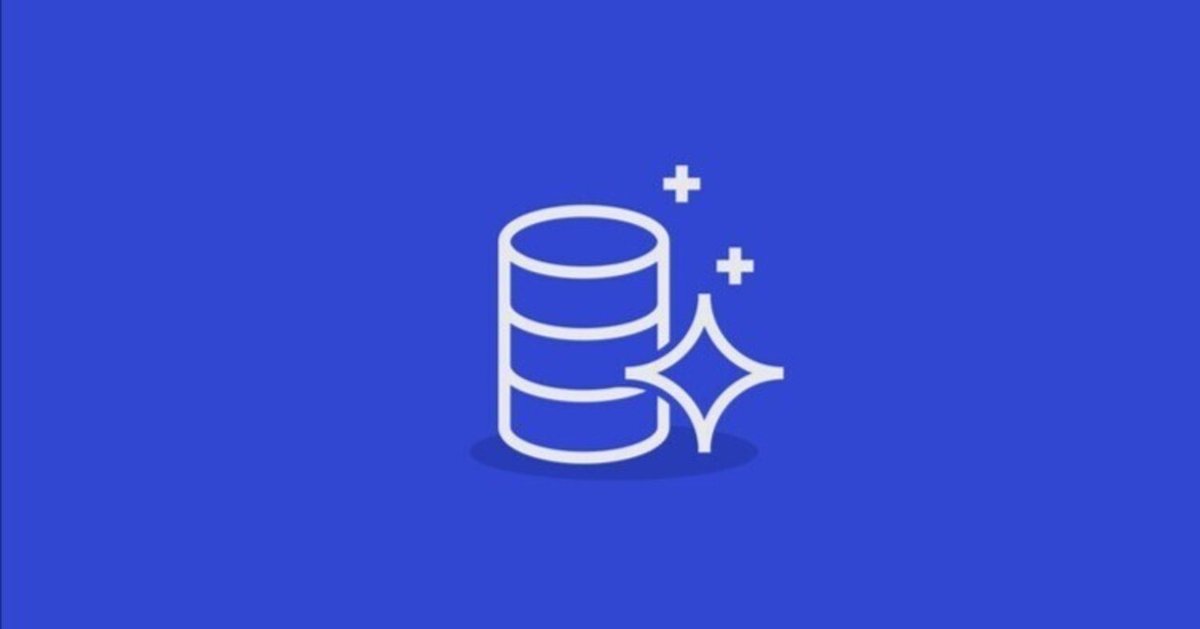
ECS & EventBridge & DynamoDBでAurora MySQLの月次データ削除バッチを自動化したよ
こんにちは、すずきです。
Aurora MySQLの不要データを削除するにあたり、データ数が多すぎて手動での削除は効率が悪いので、自動化を検討しました。今回は月単位のデータを日毎にバッチ処理で自動削除する仕組みを構築しました。
当初はEventBridge + Lambdaでバッチ処理を行うつもりだったのですが、よく考えたらLambdaの最大実行時間(15分)以内に処理が完了しないことに気がついたので、Lambdaの使用を諦めました。
そこで、ECS on FargateのタスクをEventBridgeのスケジューラーで毎日定期的に起動する構成に変更しました。
また、どのデータを削除したかの進捗管理のために、無料枠でいけそうなDynamoDBを使ってみることにしました。
構築手順
1. DynamoDBテーブルの作成
削除進捗を管理するためにDynamoDBを使用します。以下の設定でテーブルを作成します(他はデフォルトのまま)。
テーブル名: deletion_progress
パーティションキー: id (文字列)
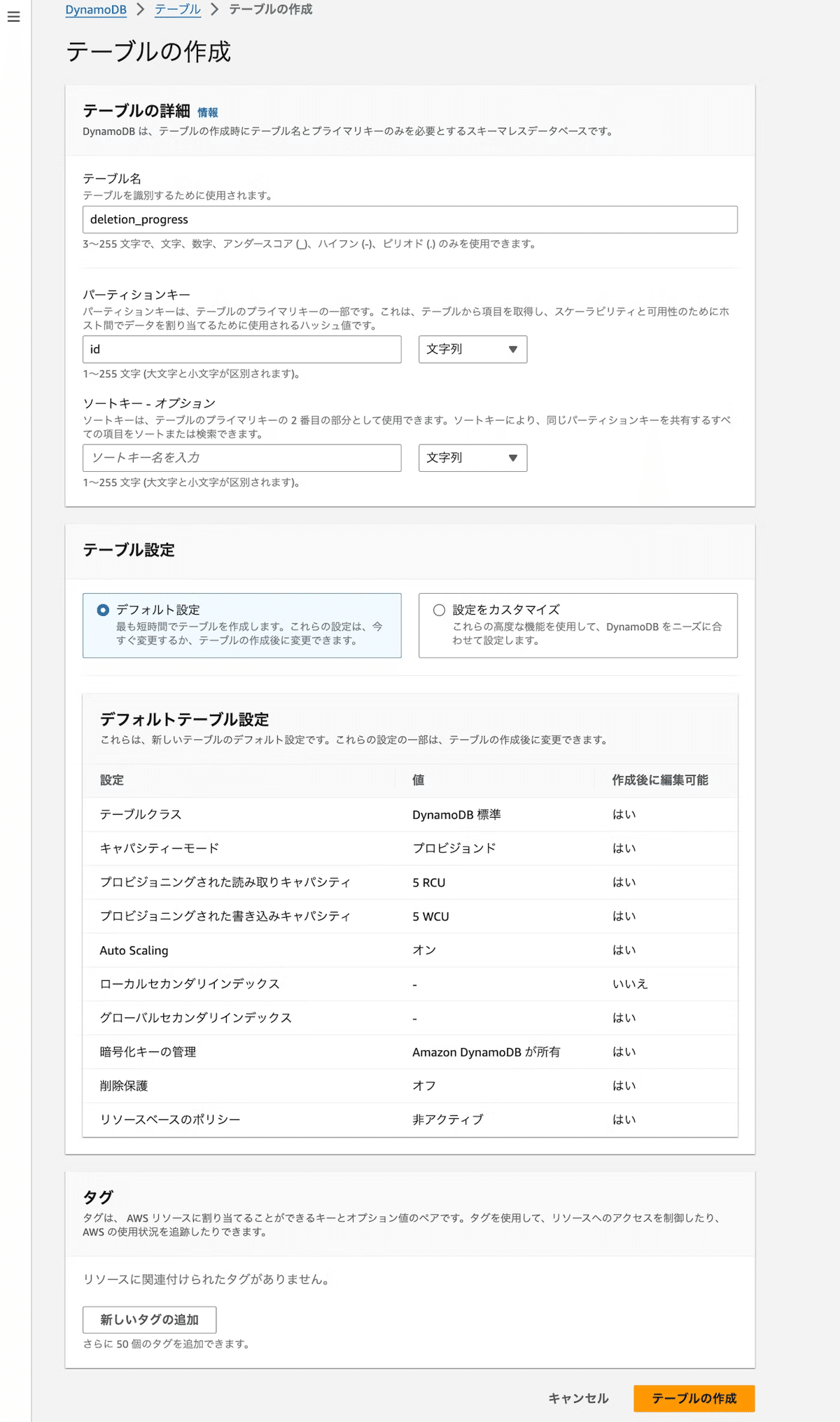
2. DynamoDB操作用のIAMポリシー作成
ECSタスクからDynamoDBへのデータ取得・保存・更新が必要なため、DynamoDB操作用のIAMポリシーを作成し、ECSタスク実行ロール(ecsTaskExecutionRole)にアタッチします。
以下のポリシーを作成し、ecsTaskExecutionRoleにアタッチします。Resourceには先ほど作成したDynamoDBテーブルのARNを指定します。
{
"Version": "2012-10-17",
"Statement": [
{
"Effect": "Allow",
"Action": [
"dynamodb:GetItem",
"dynamodb:PutItem",
"dynamodb:UpdateItem"
],
"Resource": "arn:aws:dynamodb:your-region:your-account-id:table/your-table-name"
}
]
}3. ECS用セキュリティグループの作成
ECSタスクからAuroraとDynamoDBにアクセスできるように、セキュリティグループを設定します。Auroraにはポート3306、DynamoDBにはポート443を許可します。
以下は参考のTerraformコードです。
resource "aws_security_group_rule" "ecs_sg_egress_rds" {
type = "egress"
from_port = 3306
to_port = 3306
protocol = "tcp"
security_group_id = aws_security_group.ecs_sg.id
source_security_group_id = aws_security_group.rds_sg.id
}
resource "aws_security_group_rule" "ecs_sg_egress_https" {
type = "egress"
from_port = 443
to_port = 443
protocol = "tcp"
security_group_id = aws_security_group.ecs_sg.id
cidr_blocks = ["0.0.0.0/0"]
}4. ECRリポジトリの作成
ECSタスク用のDockerイメージを保管するため、ECRリポジトリdaily-deletionを作成します。
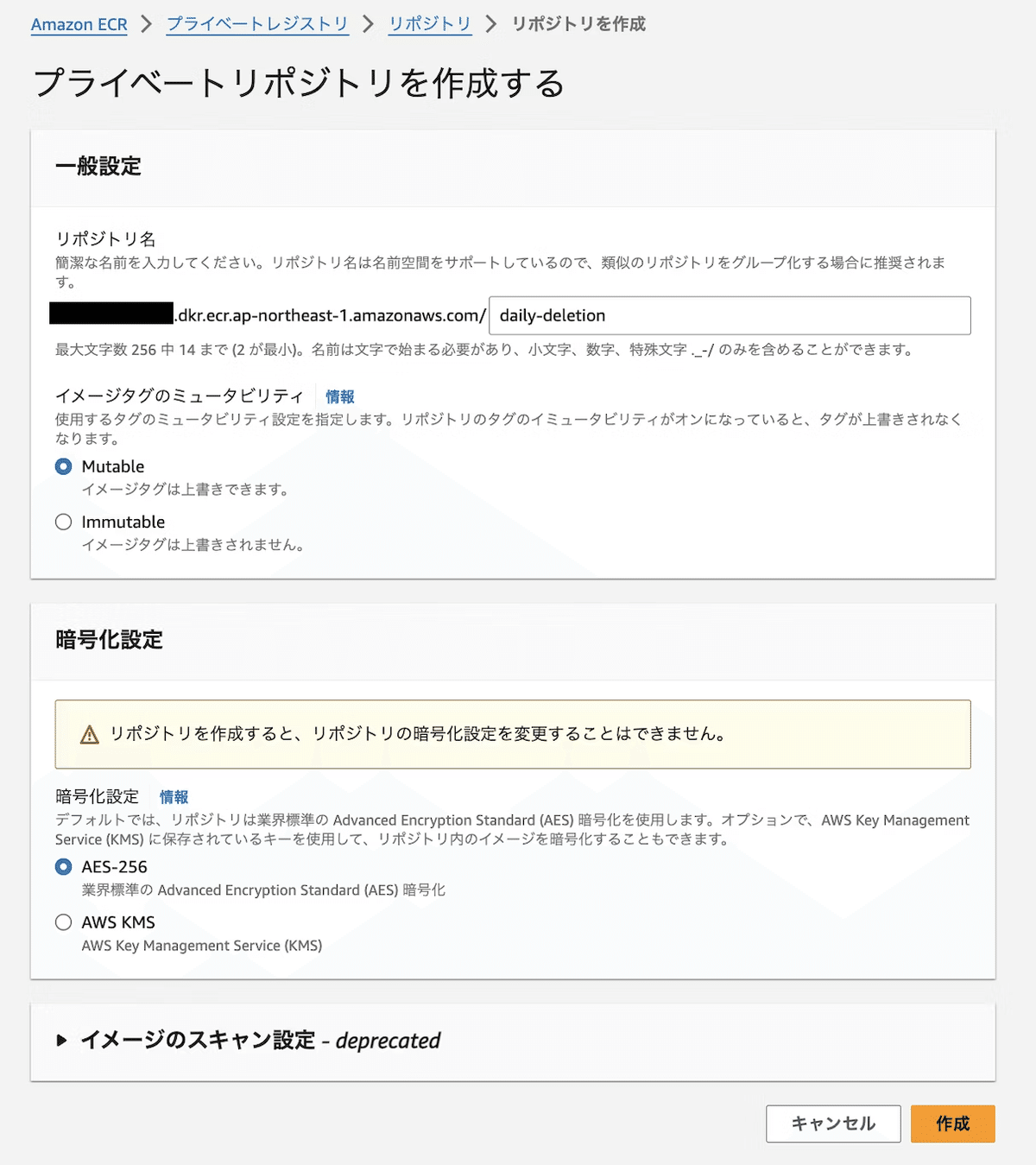
5. アプリケーションコードの作成(Python)
Aurora MySQLのoperationsテーブルから、2022年4月~2024年5月のレコードを月単位で削除するスクリプトです。DynamoDBで削除進行状況(last_year, last_month)を保存し、次回の処理に利用します。
import os
import decimal
import pymysql
import boto3
from datetime import datetime, timedelta
from logging import INFO, Formatter, StreamHandler, getLogger
RDS_HOST = os.getenv('RDS_HOST')
DB_USER = os.getenv('DB_USER')
DB_PASSWORD = os.getenv('DB_PASSWORD')
DB_NAME = os.getenv('DB_NAME')
DYNAMODB_TABLE = os.getenv('DYNAMODB_TABLE')
dynamodb = boto3.resource('dynamodb')
table = dynamodb.Table(DYNAMODB_TABLE)
logger = getLogger()
logger.setLevel(INFO)
if not logger.hasHandlers():
handler = StreamHandler()
logger.addHandler(handler)
formatter = Formatter(
'[%(levelname)s]\t%(asctime)s\t%(message)s\n',
'%Y-%m-%d %H:%M:%S'
)
for handler in logger.handlers:
handler.setFormatter(formatter)
def connect_to_db(): # MySQLに接続する関数
try:
logger.info("Attempting to connect to the database with retries")
connection = pymysql.connect(host=RDS_HOST,
port=3306,
user=DB_USER,
password=DB_PASSWORD,
db=DB_NAME,
cursorclass=pymysql.cursors.DictCursor)
logger.info("Database connection established successfully")
return connection
except pymysql.MySQLError as e:
logger.error(f"Database connection failed: {e}")
raise
def get_deletion_progress(): # 進行状況をDynamoDBから取得
response = table.get_item(Key={'id': 'progress'})
if 'Item' in response:
last_year = int(response['Item']['last_year'])
last_month = int(response['Item']['last_month'])
logger.info(
f"Retrieved from DynamoDB - last_year: {last_year} (type: {type(last_year)}), last_month: {last_month} (type: {type(last_month)})")
return last_year, last_month
else:
# 初回の場合は2022年4月を設定(進行状況がない場合はまだ何も削除されていない)
return 2022, 3 # 2022年4月を最初に削除するため、初回は3月として扱う
def update_deletion_progress(year, month): # 進行状況をDynamoDBに保存
table.put_item(Item={
'id': 'progress',
'last_year': year,
'last_month': month
})
def delete_records(year, month): # 月単位でレコードを削除する関数
try:
logger.info(
f"Starting record deletion for year: {year}, month: {month}")
connection = connect_to_db()
with connection.cursor() as cursor:
start_date = f'{year}-{month:02d}-01'
logger.info(f"Start Date generated: {start_date}")
end_date = (datetime(year, month, 1) + timedelta(days=32)
).replace(day=1).strftime('%Y-%m-%d')
logger.info(
f"Deleting records for the period {start_date} to {end_date}")
delete_query = f"""
DELETE {DB_NAME}.operations
FROM {DB_NAME}.operations
WHERE operations.created_at >= %s
AND operations.created_at < %s;
"""
cursor.execute(
delete_query, (start_date, end_date))
connection.commit()
logger.info(f"Deleted records for {year}-{month:02d}")
except Exception as e:
logger.error(f"Error deleting records: {e}")
finally:
if connection:
connection.close()
def main():
last_year, last_month = get_deletion_progress()
logger.info(
f"get_deletion_progress: {last_year}, month: {last_month}")
if last_month == 12:
next_year = last_year + 1
next_month = 1
else:
next_year = last_year
next_month = last_month + 1
if next_year > 2024 or (next_year == 2024 and next_month > 5):
logger.info(
"Deletion process has completed. No more records to delete.")
return
try:
delete_records(next_year, next_month)
update_deletion_progress(next_year, next_month)
logger.info(
f"Deletion progress updated to {next_year}-{next_month:02d}")
except Exception as e:
logger.error(f"Error during deletion process: {e}")
import traceback
logger.error(traceback.format_exc())
if __name__ == "__main__":
main()セキュリティのため、MySQL接続情報は環境変数から読み込みます。
connection = pymysql.connect(host=RDS_HOST,
port=3306,
user=DB_USER,
password=DB_PASSWORD,
db=DB_NAME,また、DynamoDBから取得したlast_yearとlast_monthがDecimal型になっているので、Pythonで数値計算できるようにIntに変換します。
last_year = int(response['Item']['last_year'])
last_month = int(response['Item']['last_month'])6. Dockerイメージのビルドおよびプッシュ
ECSタスクで参照するDockerイメージをローカル環境でビルドし、先ほど作成したECRリポジトリにプッシュします。
まず、main.pyと同階層にDockerfileとrequiments.txtを作成します。
FROM python:3.12-slim
WORKDIR /usr/src/app
COPY requirements.txt ./
RUN pip install --no-cache-dir -r requirements.txt
COPY . .
CMD ["python", "./main.py"]boto3
pymysqlローカル環境でビルドします。buildxをつかっているのは、自環境がMac M2(Arm)のためです。
docker buildx build --platform linux/amd64 -f Dockerfile -t <account_id>.dkr.ecr.ap-northeast-1.amazonaws.com/daily-deletion:latest .ECR認証します。
aws ecr get-login-password --region ap-northeast-1 | docker login --username AWS --password-stdin <accound_id>.dkr.ecr.ap-northeast-1.amazonaws.comビルドしたイメージをプッシュします。
docker push <accound_id>.dkr.ecr.ap-northeast-1.amazonaws.com/daily-deletion:latestプッシュしたらECRリポジトリを確認します。

7. ECSタスク定義の作成
JSONでタスク定義を作成します。
アプリケーションで使用する環境変数はenvironmentに定義します。
また、データ量によってはmemoryやcpuをもっと小さい値にできます(検証してみないとわからないですが)。
あと、"awslogs-create-group": "true”がないと初回のタスク実行でCloudWatchロググループの作成に失敗してエラーが出るので、注意が必要です。
{
"family": "daily-deletion-task",
"networkMode": "awsvpc",
"containerDefinitions": [
{
"name": "daily-deletion-container",
"image": "<account_id>.dkr.ecr.ap-northeast-1.amazonaws.com/daily-deletion:latest",
"essential": true,
"memory": 512,
"cpu": 256,
"environment": [
{ "name": "RDS_HOST", "value": "<cluster_endpoint_name>" },
{ "name": "DB_USER", "value": "<mysql_user_name>" },
{ "name": "DB_PASSWORD", "value": "<mysql_user_password>" },
{ "name": "DB_NAME", "value": "<db_schema_name>" },
{ "name": "DYNAMODB_TABLE", "value": "deletion_progress" }
],
"logConfiguration": {
"logDriver": "awslogs",
"options": {
"awslogs-group": "/ecs/daily-deletion",
"awslogs-create-group": "true”,
"awslogs-region": "ap-northeast-1",
"awslogs-stream-prefix": "ecs"
}
}
}
],
"requiresCompatibilities": ["FARGATE"],
"cpu": "256",
"memory": "512",
"taskRoleArn": "arn:aws:iam::<account_name>:role/ecsTaskRole",
"executionRoleArn": "arn:aws:iam::<account_name>:role/ecsTaskExecutionRole"
}
8. EventBridgeスケジュールの作成
これまでECSタスクを立ち上げる前にECSサービスを構築していたので、今回もそうするものだと思いこんでいたのですが、バッチ処理をする際はEventBridgeから直接ECSタスクを立ち上げるということを初めて知りました。
「EventBridge > スケジュール」からスケジュールパターン(今回は毎日AM3:00)、タスク定義、サブネット、セキュリティグループなどを選択します。
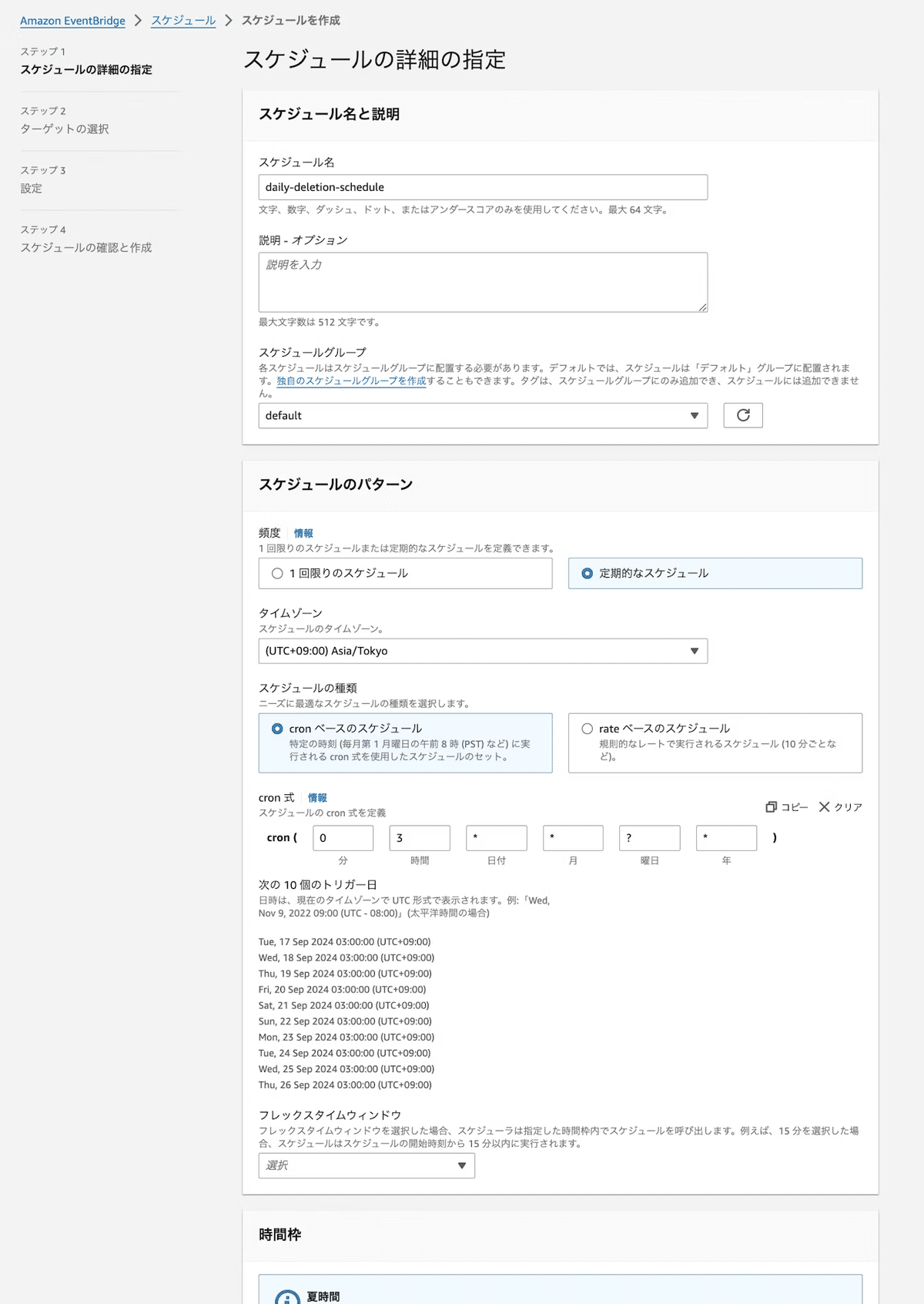
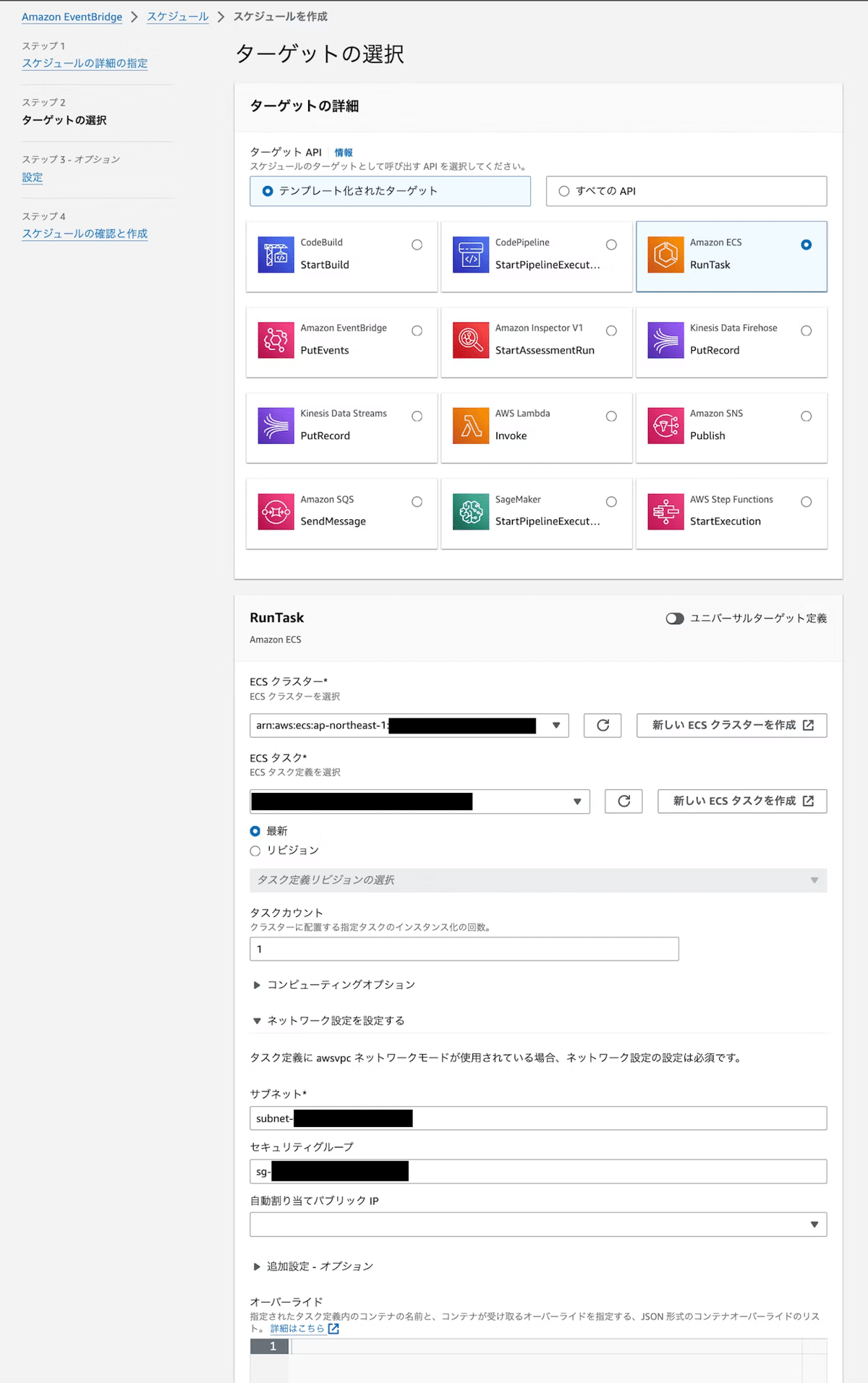
動作確認
CloudWatch Logsでレコードが正しく削除されたことを確認しました。

